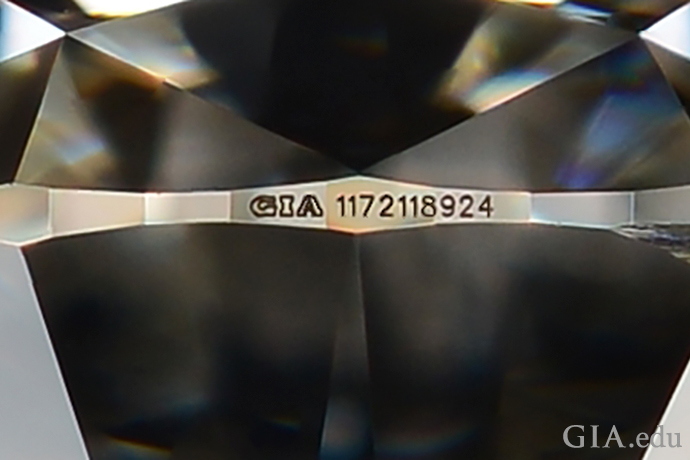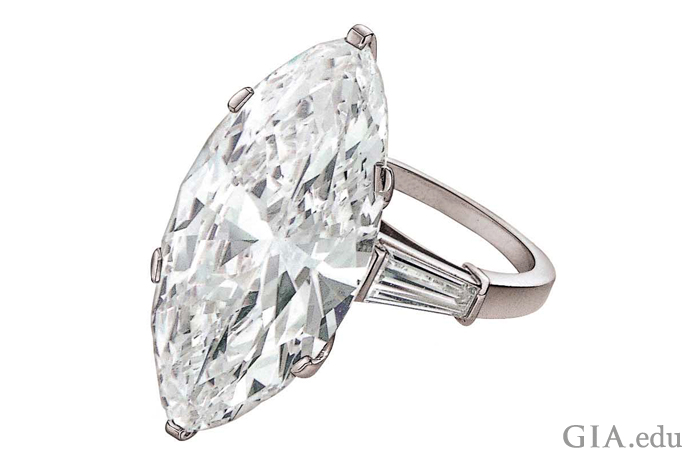Protect your diamond engagement ring from damage or loss by making the right buying decision and then keeping it like new for the rest of your life. Here are some tips on how to safeguard your treasured possession.
1. Before You Buy, Learn About Diamond Durability
Diamonds are the hardest gemstones on earth – they rank 10 on the Mohs scale of hardness – but they can still suffer damage. Diamonds have clarity characteristics called blemishes and inclusions. Blemishes are confined to the diamond’s surface. Inclusions are internal characteristics either totally enclosed within a diamond or extending into the diamond from its surface.
Generally, if a diamond has significant durability problems, it doesn’t survive the friction and pressure of the cutting process. However, certain types of inclusions, especially if they’re near the girdle, can make a cut diamond more vulnerable to damage. (A girdle is the middle portion of a diamond, a narrow section separating its upper (crown) and lower (pavilion) parts, and functioning as the diamond’s setting edge.) For example, if the stone is hit precisely on a feather or other surface-reaching inclusion, it might chip. Likewise, very deep feathers that extend from the crown to the pavilion, or that penetrate about one-third of the way or more into the diamond, could pose durability concerns. The size, number, location, relief and nature of the inclusions within a diamond are considered when its clarity grade is assigned. You should take into account the types of clarity characteristics before you purchase the stone.

A chip is a damaged area, usually near the girdle of a diamond. Photo: John I. Koivula/GIA
A GIA Diamond Grading Report contains essential clarity information about the diamond you’re considering. In addition to providing an objective assessment of the diamond’s color, cut and carat weight, the report also contains your diamond’s clarity grade along with a map of your diamond’s clarity characteristics. Called a plotting diagram, the color-coded map shows the types of inclusions and blemishes the diamond has and their precise locations. Learn more about the plotting diagram.

Since the corners on a princess cut diamond are vulnerable to chipping, select an engagement ring setting with V-shaped prongs to protect them. Courtesy: TrueFacet.com
2. Know Which Diamond Shapes and Cuts Will Require Special Care
Some diamond shapes and cuts are more vulnerable to chipping than others because they have points or sharp corners. The rectangular or square shaped princess cut is one example. The marquise, pear and heart shapes are others. This is not to say you shouldn’t buy one of these shapes; just make sure your diamond is in a setting that protects areas that are more susceptible to chipping. Very thin girdles, sometimes called knife-edge girdles, also pose a greater risk of damage, regardless of the diamond shape.
Diamonds have cleavage, which is the tendency of certain gems and minerals to break or split somewhat easily along crystallographic planes due to their atomic structure. Diamonds are tougher in the directions where the atoms are bonded tightly together, and less tough where they’re not so tightly bonded. This means that diamonds are more likely to be damaged on or near a cleavage plane.

The corners of a princess cut are more vulnerable to chipping since they lie close to a cleavage plane. Illustration: Al Gilbertson/GIA
3. Protect Your Diamond by Choosing a Secure Setting
A diamond in an engagement ring is often held in its mounting by prongs. A prong is a narrow metal support, typically used in groups of four to six. When it comes to protecting your diamond, a six-prong setting can offer more protection than a four-prong setting. In the event a prong breaks, a six-prong setting is more likely to hold the diamond in place. The two additional prongs might also provide a little extra protection for the girdle during daily wear. There are pros and cons to using four or six prongs.

Four prongs can provide an adequate degree of protection and hold your diamond securely. Courtesy: 1stdibs.com

This 1.37 carat (ct) diamond is secure in a six-prong setting. If one prong breaks, the other five will probably hold the stone in its place. Courtesy: 1stdibs.com
Another choice that offers considerable protection is the bezel setting – a style in which a thin metal strip is pushed or hammered around a gem to hold it in place. A bezel setting helps prevent the center stone from falling out, and it protects the girdle against bumps, bangs and other accidents. Partial bezels and V-shaped prongs also protect vulnerable points and corners of diamonds.

The 0.53 ct diamond in this bezel setting is well protected. Courtesy: 1stdibs.com

Although striking and unusual, a tension setting may be a riskier choice for an engagement ring. The diamond, which appears to be suspended in air, is held in place by the inherent force in the two opposing sides of the metal setting. Photo: Robert Weldon/GIA. Gift of Steven Kretchmer and Eightstar Diamond Company
4. Protect Your Diamond with a Laser Inscription
Diamonds graded by GIA often have their grading report numbers microscopically inscribed on their girdles. This laser inscription is automatically applied to all diamonds that come with either a GIA Diamond Dossier or Diamond FocusTM report. It’s an optional, low-cost additional service for diamonds with GIA Diamond Grading Reports.
A laser inscription serves as a secure identifying feature, which links the diamond to its specific report data. Viewable under 10× magnification with a simple jeweler’s loupe, the inscribed report number can be matched to the diamond’s physical report or entered into GIA Report Check, GIA’s online database containing the diamond’s grading details. Should your diamond be stolen and later recovered, a laser inscription may help the police identify it.
By the way, you’re not limited to inscribing a report number – you can also inscribe a short message, a special date or other meaningful symbol.

A diamond with a laser inscription can give you added peace of mind. Photo: Al Gilbertson/GIA
5. After You Buy, Get Your Diamond Appraised and Insured
The emotional value of your engagement ring is priceless, but it does have a monetary value. That’s why insuring it is a smart thing to do. Most homeowner’s and renter’s insurance policies offer relatively inexpensive coverage for jewelry theft. Make sure your policy also covers damage and loss. Be sure to read it carefully.

An engagement ring represents so much that you’ll want to make sure it’s a lifetime companion. Courtesy: Sylvie
Many insurance companies will require an appraisal in order to determine your diamond engagement ring’s replacement value. An appraisal is an evaluation of diamonds or other jewelry, usually for insurance or estate purposes. Appraisals normally provide a detailed description of the pieces being appraised, including the exact measurements of the important gemstones, together with (for diamonds) their color and clarity grades, plots showing the location of inclusions or blemishes, and information on the properties and make. They then state an estimated value.
You can find a local appraiser by consulting a list of professional appraisal associations. Many of these organizations require that their appraisers have a GIA Graduate Gemologist (GG) diploma in addition to supplemental appraisal training. They also expect members to uphold the highest ethical and professional standards.

You’ll want to insure this 1.03 ct heart-shaped diamond engagement ring. The V-shaped prong at the point helps protect the diamond from damage. Courtesy: Leo Ingwer
6. Protect Your Diamond by Taking It Off
Diamond engagement rings are meant for a lifetime of daily wear, but they’re not indestructible. Prongs can shift and loosen over time. Exercise, gardening, catching on clothing and accidental bangs all may take their toll.
Even washing the dishes with an engagement ring on isn’t ideal (how many stories have you read about a ring going down a drain?). Wearing it in cold weather can be risky; fingers shrink and rings can slide around. A good way to protect your diamond is to remove your engagement ring before these kinds of activities.
You’ve heard that only a diamond can scratch a diamond? Well, storing or wearing diamond-set jewelry items next to each other can cause chips and other damage as well as scratches. One solution is to store your diamond ring or other jewels individually in padded boxes or soft pouches. Make sure you place only one piece of jewelry in each bag or box.

To protect the 1.01 ct pear shaped diamond and surrounding melee, be sure to take the ring off before gardening or performing other risky activities. To avoid inadvertently scratching or chipping the stones, store the ring individually in a box or soft bag. Courtesy: 1stdibs.com
7. Protect Your Diamond Engagement Ring with Regular Check-Ups
It’s a good idea to get the prongs in your engagement ring checked every six months for potential damage. If this seems too frequent for you, use your yearly wedding anniversary as a convenient reminder to get the prongs checked. Many insurance companies also require that the ring receive regular check-ups. Contact your carrier to find its requirements.
Tightening prongs is a routine task for a bench jeweler. You can check if a prong is loose by seeing if the stone moves when you gently push it (if it moves, it’s loose). Gaps between the diamond and the setting are another warning sign. Look at the ring with a 10× loupe to help see such gaps and spot damaged prongs.

A breathtaking sight: An 11.17 ct marquise is held in place by six prongs. Tapered baguettes decorate the shank. Photo: Valerie Power/GIA
8. Keep Your Diamond Engagement Ring Clean
Dirt won’t break or chip your diamond, but it will dull its appearance. You can clean your diamond by using a lint-free cloth or washing it with warm water, mild soap and a soft toothbrush. Don’t use abrasive household cleaners, or steam cleaners. Ultrasonic cleaners are safe for untreated diamonds; however, treated diamonds can be damaged by ultrasonic cleaners. You can briefly dip your diamond in a commercial jewelry cleaning solution. It’s also a good idea to have your ring periodically cleaned by a professional jeweler. If you follow the check-up advice above, your diamond engagement ring will retain its sparkle for a lifetime.
Now that you know how to protect your diamond, it’s time to debunk eight common diamond engagement ring myths.
